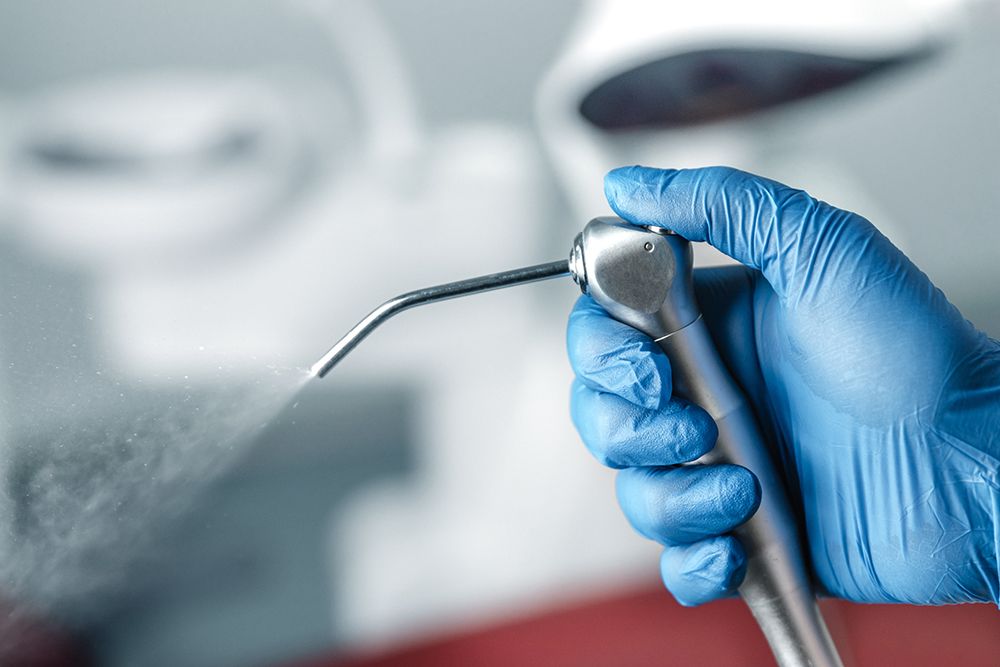Waterline Maintenance Is Not Difficult and Should Not Be Ignored
Practices need to stay on top of dental unit waterlines and make sure to keep thorough documentation on the maintenance steps that are being performed.
ALEXANDER / STOCK.ADOBE.COM

In 2015, an outbreak of nontuberculous mycobacteria (NTM) infected 24 patients at a pediatric dental practice in Georgia. As shocking as that was, it was only the next year when 71 more cases occurred at another pediatric dental practice in California. In both cases, the infection was traced back to contaminated dental unit waterlines.
It seemed like those 2 cases would’ve been enough of an alarm for dental practices everywhere. Although some practices heeded the warning and became mindful of the dangers, regrettably, others did not. A similar outbreak happened in March 2022, again at a pediatric dental practice, prompting the Centers for Disease Control and Prevention (CDC) to issue an advisory.
“This advisory, of course, spurred a lot of awareness—again—about the importance of dental unit waterlines. Because in 2015, we had the same kind of outbreak in Georgia, and in 2016, we had it in California,” Katherine Schrubbe, RDH, BS, MEd, PhD, infection prevention consultant, says. “There were [a lot] of children who ended up with infections, hospitalizations, and long-term antibiotics—some of them even had to have surgeries.”
Awareness
The recent outbreak seems surprising, especially because 2 other notable outbreaks occurred just a few years prior. One would assume that those incidents would’ve served as a wake-up call—but apparently, they did not.
“It was a wake-up call for people like us,” Lisa Kane, DMD, a consultant at Dental Office Compliance of New England LLC, says. “I’ve been talking about those cases in my classes, and [very few people] knew what I was talking about. Even now that it’s been out in the news, still very few people know what happened. Every once in a while, I’ll get someone who will email me and say, ‘Oh my gosh, did you see this?’
If you’re interested in thinking about this stuff, you’re going to be reading things about infection control, checking OSHA [Occupational Safety and Health Administration], and checking the CDC,” she says. “But if you’re busy in your practice, you don’t really have time for any of this, which is why I started doing what I’m doing….I always say, ‘You don’t know what you don’t know.’”
The seeming lack of industry-wide action may simply be a lack of realizing the issue’s importance, according to Kane. “People don’t understand,” she says. “Maybe it wasn’t prominent enough for people to realize. I don’t think people take it seriously. Most offices I go to, I’ll ask them [whether] they’re water testing, shocking, or treating, and they always tell me [that they] have distilled water or bottles. I don’t think there’s a huge lack of understanding of the bigger picture, I think people just don’t understand that [things like] biofilm can form, even if you’re using distilled water, even if you’re treating your water, and even [if you’re monitoring] it. I don’t think people get that. A lot of people [also] have older chairs that they don’t have bottles attached [to], so I recommend that everybody retrofits it.”
Following the March 2022 outbreak, the situation became so stark that the medical community advised, in cases of NTM, checking for any prior dental care and the potential for tainted water. “The interesting thing was this health advisory, where there were recommendations for dental providers [as well as] medical providers,” Schrubbe says. “It said, ‘Consider an odontogenic source for cervical lymphadenitis or lymphadenopathy and assess a history of dental care and procedures in all children presenting with lymphadenitis.’ This cued the medical providers to look for a dental source. It just puts us all on high alert that our medical providers are also involved in this and [are] watching for these things. And if they see this, they should consider that it maybe came from a dental source, which could be dental unit water.”
How Did We Get Here?
So how did something like this occur again? Is it something new or did we just get lax? “In these cases, the dental unit water was not being treated,” Schrubbe says. “In at least 1 of these clinics, there was some plumbing that had a dead-leg pipe—it ended and was capped. So the water was sitting overnight and stagnating, then the staff would come in the morning, turn all the units on, and this stagnant water was being pushed out into the dental units without being treated.
“As a result, a high number of common waterborne bacteria were found in untreated systems,” she says. “Sometimes practices say [that they] buy sterile water or distilled water for [their] dental unit water, [but] it doesn’t matter. No matter what, untreated dental unit water can create this biofilm. The water going through dental unit tubing creates a slime layer in the lining of the tubing. Biofilm is a community of bacterial cells and other microbes that adhere to surfaces and form a protective slime layer. For most people, these bacteria are not going to be critical, but for patients [who] are immunocompromised, or if you’re doing procedures like pulpotomies and exposing nerve and blood supply in the head, use of contaminated water is a big problem.”
Maintenance
The unfortunate reality, in cases where waterlines are poorly maintained, is that their treatment is not especially difficult. “Waterline maintenance is very easy,” Kane says. “Start with treating your bottles. I’m a big fan of the tablets, because I feel like those are easy. I like the tablets from a cost perspective and from an ease of shocking perspective. Flush your lines in the morning. Flush in between every patient for 20 seconds—at least all the lines—then test and shock quarterly. If you do all those things, you’re pretty good.”
Additionally, Schrubbe says that every practice should be treating their waterlines daily. “There are tablets, cartridges, [and] drops [that] staff can use that are all EPA [Environmental Protection Agency] registered. You have to be doing this daily. Some people drop in a tablet [every time they fill up their water bottle]. Some practices have a blue-looking straw or [a] cartridge that hangs off the unit and goes into the water bottle. They fill up their water bottle and screw it on over the cartridge, which elutes a certain chemical—maybe some iodine [or] silver—just a little bit into the water so the water bacteria is in check.”
Performing regular maintenance also involves testing to ensure dental unit waterlines meet acceptable water quality standards (ie, < 500 CFU/mL heterotrophic bacteria).
“Now the question becomes: How do we know [whether] our daily treatment is really working?” Schrubbe says. “How do we know it’s safe? The recommendations from the CDC and [the Organization for Safety, Asepsis, and Prevention] say [that] if you’ve never tested your dental unit water, you should begin testing, and [to] test each unit at least once a month until you get consistent results. [So] let’s say you have 4 dental units, you test them in January, [and] they all pass. Great, now we’re going to test the water again in February. [If] 2 of them [don’t] pass, those 2 units need to be tested again in March until we get consistent results for 2 months. Once you have passing results for 2 months, then you can test your units quarterly, and log your results.”
However, sometimes it’s necessary to shock the waterlines, as this cleans out bacteria and biofilm that builds up over time. “It’s like when people shock their swimming pools,” Schrubbe says. “Some people have wells; for instance, I have a well in my backyard. I don’t have municipal water. So we test it, and sometimes it has to be shocked. The same thing happens with dental units. Shocking should be done before you’re going to use whatever product you have chosen for your daily treatment or if a practice decides to change daily treatment products. Let’s say you’re using product A; you’ve been using it for a long time and you want to move to product B. Before you switch products, you need to shock your lines, because it’s too much mixing of chemicals. You need to clear the lines just like you would shock your pool before you put in the other chemicals in the water.”
Practices should also shock their waterlines if a test reveals a contamination level of 200 CFU/mL or higher.
Documentation
Another key component in waterline maintenance doesn’t involve the waterline itself. The practice should keep good documentation that those steps have been performed. Doing so can help keep you out of trouble.
“It’s very important that you log your results,” Schrubbe says. “You should log because that’s the protocol, but you should also log because it protects the practice. If somebody comes in and says, ‘I was just diagnosed with Legionnaires disease and they told me to come back and check with my dentist because I had a dental appointment last month,’ then that log can come out and that practice can say, ‘We follow the protocol from CDC, use an EPA-registered antimicrobial product, and here is our log. We test our dental unit water on a regular basis according to the protocol, and we have all passing results. You did not get this here.’”
Keeping a log is best to have for your own record keeping and for liability purposes, according to Kane. “Washington state now has mandated quarterly testing and shocking, and other states require it on a periodic basis. If the state ever wanted to see [the documentation] or if you ever had an issue [in which you could show] that you’re actually [completing] it and have documentation of it, then you’re in a much better position—liability- or risk-wise—than if you just said [you] water test but [have] no written documentation of it,” she says.
Dental unit waterline maintenance isn’t at all difficult. Heeding the warnings from the headlines should be enough for practices to realize just how important the task is. Hopefully, given last year’s outbreak and the resulting CDC advisory, more practices are paying attention.
